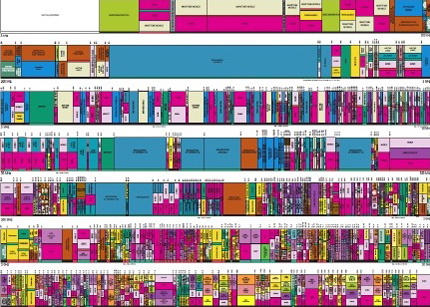|
The World Radiocommunication Conference
2015 (WRC-15) concluded its deliberations as delegates signed the Final Acts
that revise the Radio Regulations, the international treaty governing the use
of radio-frequency (RF) spectrum and satellite orbits. Around 3,300
participants, representing 162 out of ITU’s 193 member states attended the
four-week conference 2—27 November 2015. Approximately 500 participants
representing 130 other entities, including industry, also attended the
conference as observers.
WRC-15 addressed more than 40 topics related to
frequency allocation and frequency sharing for the efficient use of spectrum
and orbital resources. Following the growing demand for spectrum for mobile broadband
services, WRC-15 identified frequency bands in the L-band (1,427–1,518 MHz) and
in the lower part of the C-band (3.4–3.6 GHz). WRC-15 achieved agreement on
some additional portions in other bands that were also allocated to mobile broadband
services to be used in regions where there was no interference with other
services.
To counteract the difficulties encountered in finding additional
spectrum for IMT in bands below 6 GHz, WRC‑15 decided to include studies in the
agenda for the next WRC in 2019 for the identification of bands above 6 GHz
that will allow technology to meet demand for greater capacity. WRC-15 made a
key decision that will provide enhanced capacity for mobile broadband in the
694–790‑MHz frequency band in ITU Region 1 (Europe, Africa, the
Middle East, and Central Asia) and a globally harmonized solution for the
implementation of the digital dividend.

Full protection has been given to
television broadcasting as well as to the aeronautical radio-navigation systems
operating in this frequency band. The decision allocates this band to the
mobile service and identifies it for IMT in ITU Region 1, similarly to what was
decided by the WRC in 2007 for ITU Region 2 (Americas) and Region 3
(Asia-Pacific). WRC-15 identified spectrum in the 694–894-MHz frequency band to
facilitate mobile broadband communications for robust and reliable mission critical
emergency services in public protection and disaster relief, such as police,
fire, ambulances, and disaster-response teams.
WRC-15 opened the way for the
development by the International Civil Aviation Organization of worldwide
standards for unmanned aircraft systems, and identified the regulatory
conditions that may be applied to such systems internationally. WRC-15 also
agreed on spectrum for wireless avionics intra-communications to allow for the heavy
and expensive wiring used in aircraft to be replaced by wireless systems.
Ofcom (United Kingdom) has confirmed plans for releasing
valuable new airwaves that could be used to meet the growing demand for mobile broadband
services. An auction is planned to take place in early 2016 for the spectrum,
which has been made available by the UK Ministry of Defence as part of a wider
government initiative to free up public sector spectrum for civil uses. A total
of 190 MHz of high-capacity spectrum is being made available in two bands—2.3
and 3.4 GHz—which are particularly suited for high-speed mobile broadband services.
Ofcom proposes to auction the spectrum in lots of 10 MHz for the 2.3-GHz band and
5 MHz for the 3.4-GHz band.
Read the full article in IEEE Vehicular Technology Magazine, Volume
11, Issue 1, March 2016. |